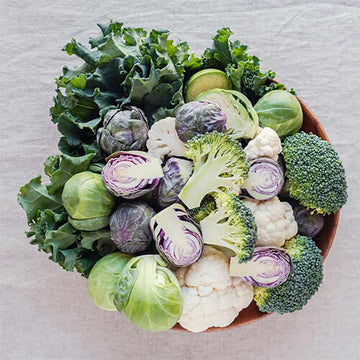Vacuum Sealing Broccoli, Cruciferous Vegetables
Broccoli is a member of the cruciferous vegetable family which also includes Cauliflower, Cabbage, Brussels sprouts, Kale, Radishes, Bok Choy, Turnips and the onion family to name a few. They are marked with florets or bulbs. It is said that this group of vegetables should not be vacuum sealed.
This both true and false.
These vegetables can not be vacuum sealed straight into a bag or a container as the emit a gas into the bag or container and actually blow the bag up. This gas will also cause the vegetables to spoil very quickly as they are surrounded by it. So, to successfully vacuum seal these vegetables in a vacuum bag or a vacuum container you must do 2 things
- Partly cook them or blanch the vegetable.
- Place the vacuum bag or the vacuum container in the freezer once the vegetables are in it.
To par cook or blanch your vegetable before vacuum sealing place them in water with a pinch of salt and bring to the boil. Boil them until they are tender but still crisp, 3 – 5 minutes depending on the vegetable. Use a spoon to keep them submerged. Once done use tongs to remove them and place them straight into ice water to cool them off quickly and stop them from continuing to cook. Then drain them dry and pat the excess water off them before vacuum sealing.
So you will find a lot of information on these foods saying you can not vacuum seal them, but in truth you can as long as you follow a few simple steps before doing so.
Other food that should not be vacuum sealed unless…
- Raw mushrooms should not be vacuum sealed as they will ripen and spoil very quickly. BUT cooked mushrooms are fine.
- Fresh Bananas should not be vacuum sealed as they also will ripen much more quickly. But they can be peeled, sliced and frozen then vacuum sealed quite fine.
- Raw Garlic or Onion will blow the bag up and will go off really quickly. BUT once again if it is cooked and frozen then it is fine.
- Soft Cheeses such as blue cheese, Brie, Camembert, Ricotta and any unpasteurized cheeses will produce mold much quicker when vacuum sealed. BUT any of your hard cheeses are fine to vacuum seal.
- Whole Apples should be cut into slices before vacuum sealing and freezing. If you rub a little lemon juice onto them it will also stop discoloring.
- Any Hot Food should not be vacuum sealed until it is completely cooled off before vacuum sealing it in a bag or vacuum container. It is best to do this by placing it in the fridge before vacuum sealing it.
- Any Natural Fibers such as wool or furs are ok to vacuum seal for up to 3 - 4 months but beyond that it will start to cause damage as the fibers require air to breath and keep their natural shape.


